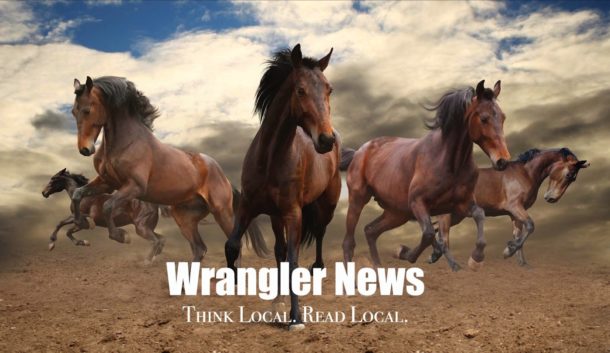Story by Georgia Swing
Photo by Billy Hardiman
 Singer-songwriter Walt Richardson looks back at
Singer-songwriter Walt Richardson looks back at
35 years of entertaining Tempe audiences and
says he feels like he’s just beginning.
For his iconic role in more than three decades
of the Mill Avenue music scene, for mentoring new
generations of musicians, and for the promise of
much music still to come, Richardson was inducted
Jan. 18 into the Arizona Music and Entertainment
Hall of Fame.
He joins Alice Cooper, Stevie Nicks, Wayne
Newton, Steven Spielberg, Tanya Tucker and Glen
Campbell – among others – in being recognized
for having “a significant impact on the evolution
and development of the musical and entertainment
culture in the state of Arizona.”
“It seems like everyone knows Walt
Richardson,” said Don Fassinger, manager of the
Tempe Center for the Arts.
“He’s been such an important part of the growth
of the musical history of Tempe.”
“If you walk around the same corner for 30
years, people say, ‘Hey, there he is. That guy must
be an icon. Or a fixture,’” Richardson said with a
chuckle last week during an interview with Chris
Latella of Channel 12 News on the mezzanine of
Tempe Center for the Arts.
Perched on a stool with Tempe Town Lake in the
background, he obliged Latella by singing his classic
“Mill Avenue” and accompanying himself on rhythm
guitar for the camera.
I’m not the only one out here paying dues.
They watch reconstruction from a cafe on the
move.
I’m still surviving changes down on Mill
Avenue.
With the TV camera turned off and packed up,
Richardson tucked his dreadlocks beneath a brown,
orange and green knit cap.
“They’re extremely long; they’re down to my
ankles,” he said of the coils of hair that signal the
strong influence of reggae on his folk-rock music.
“It’s just a way of keeping it out of the way.”
Moving to a small sofa nearby, he began his
second, 45-minute interview with a newspaper
reporter.
Richardson said he was drawn to reggae
the first time he heard its distinctive lump-thub
rhythm. “So when you are playing the beat, you’re
almost following the same kind of rhythm when
you’re hearing the whole heartbeat,” he said—“even
complete with a little rest in there.”
Anniversaries and milestones — A
convergence of milestones has placed the spotlight
more prominently than usual on Richardson who,
in addition to his Hall of Fame induction and soldout
reunion concert the day of his induction with
longtime band Morning Star, turned 60 three days
later.
On Feb. 12, Tempe Center for the Arts will
celebrate the fifth anniversary of the popular
Richardson-hosted Walk-in Wednesdays Open
Mic Night, which has spun off into a more highly
produced set of round-robin concerts by small groups
of well-known local musicians and a twice-yearly
Songwriters’ Showcase aired on PBS.
The night of the Walk-in Wednesdays
anniversary is also expected, by chance, to include
the 3,000th performance of the open mic series.
The musician who lucks into that slot will receive an
array of prizes, including a trophy, a gift basket and
free music lessons.
Fassinger conceived Walk-in Wednesdays as
a way to bring a greater cross-section of the local
population into the Center for the Arts.
“The goal was to activate the lounge,” the arts
center manager said. “We have been able to build a
community of tremendously supportive and attentive
singer-songwriters and fans of singer-songwriters.”
Richardson, on board from the beginning, has
played “an integral part” in Walk-in Wednesdays’
success, Fassinger said.
Father honored as hero — Though he
answered questions about himself with patience and
frequent pauses for thought, Richardson was most
enthusiastic when talking about his father, Walter
Richardson Sr., also a musician and recipient of the
Congressional Gold Medal for his role with the famed
Tuskegee Airmen of World War II.
Richardson Sr., a member of the ground crew
for the segregated Black pilots’ group at Tuskegee
Army Airfield, was among the men chosen to
integrate the U.S. Air Force in the 1940s at the
command of President Truman.
“They picked 300 officers and they picked 1,500
enlisted men that they felt were capable of going
into all-White units around the world and making it
work,” Richardson said.
“He was sent to Okinawa to an all-White unit,
and that’s where the whole legacy of the Air Force
being integrated started.”
Four years ago, Richardson’s father, now living
with his mother in Florida, received the nation’s
highest civilian honor in a dignitary-studded
ceremony.
Richardson’s experience as a military brat
stationed with his family around the world left a
permanent stamp on his global taste in music and his
philosophy about material possessions.
He said he feels great satisfaction – and feels
“free” – at having made a career-long living in music.
“I live a lifestyle that I don’t live beyond my
means,” he said. “I’ve lived in a lot of countries, so I
know what we have here that a lot of people have lost
sight of in terms of what you think you need.
“When I look at houses, to me, they’re simply
shelters,” he said. “So how big does your shelter need
to be? It’s just to keep the weather off of you, a place
where you can rest, turn around and rejuvenate.”
He has lived in simple fashion for years in
a converted garage. “It works because I’ve never
married,” he said.
“Marriage and family, all those things are
choices and…looked like they required a lot of you,
and I wasn’t in it the same way I’m in my music.”
Searching for a voice — The oldest of eight
children, Richardson and his siblings blended their
voices as “a game,” and he bought his first guitar at
age 9 for $15 from the Spiegel catalog. Among his
musical mentors were the Beatles, Cat Stevens, Bob
Marley and Eric Clapton. He “practiced, practiced,
practiced” to capture some of the flavor, dialect and
rhythms of the music he listened to.
“Eventually you have to move away from
that and go back to yourself,” he said. “One of the
things that’s really important about any art form is
when you find yourself, or you find your voice. And
searching for your voice can be, well, actually, it’s a
lifetime journey.”
Encounters with funk and reggae introduced
him to a wide range of African music, and he’s
intrigued by mixing indigenous polyrhythms with
soca, calypso and ska.
“It’s just crazy,” he said. “You just keep mixing
them.”
He came to Arizona in 1974 to finish college,
and he graduated from Arizona State in 1977 with
a degree in speech and communications. “After I
finished college I didn’t have anything in mind as to
where to go, and I thought I’d hang out here for a
while,” he said, laughing his low, rich laugh.
“I’m still hanging out.”
In the heyday of live music up and down Mill
Avenue, he took a friend’s suggestion to try an open
mic night. The rest is Tempe music history.
Hot clubs, intimate connection — Center
director Fassinger, who has watched Richardson’s
career of the years, had yet more memories of
Tempe’s musical heyday.
“At that time there were venues that had live
bands on a very regular basis,” Fassinger said. “Walt
would be playing a set at Chuy’s, and when they went
on break, he ran down the street to hear another
band.”
The small clubs didn’t always have working
air-conditioning, Richardson recalled, but what they
did have was crowds of avid music fans who enjoyed
forging an intimate connection with the music and
the artists.
Among the forces keeping Richardson in Tempe
is his love for the weather, the desert and especially
the people.
“There is an air in Tempe that’s very innovative
and progressive because of the influence of the
university,” he said. “The university has got so many
progressive projects going on. When you’re watching
the Discovery Channel, you see the professors that
are speaking about different aspects of the universe
— they’re right down the street here.”
The Arizona Music and Entertainment Hall of
Fame nomination is “a great validation of all the
work,” Richardson said, “and it is an honor to have
my name there so that my nieces and nephews and
everybody going forward, they have more of a story
to tell in their tree of what their uncle did.”
Of being grouped with such an illustrious list of
entertainers, he said:
“Every person that’s represented in that place,
they have something specific that people enjoy. I
don’t look at myself being placed in there as ‘I’m
just as good as that person.’ I look at it that there’s
something specific that I’ve brought to the table, too,
that people have embraced.”
‘Nobody has to listen to you’ — Richardson
is regularly asked to speak to young students about
choosing a career in the arts. He passes on to them
the message that “choice is everything. Everything
that you are doing in your life is a result of choices
that you make. And being an adult means the ability
to be accountable for the choices and decisions that
you make.”
As for being a musician, he tells them:
“Just because you play an instrument, nobody
has to listen to you, and it doesn’t matter how well
you play it. … If you approach the music industry or
your talent from the aspect that you’re providing a
service for people, people make more of an emotional
connection to you.”
He compares this point in his career to having
a white belt in karate because a friend in martial arts
told him:
“Always being able to begin is the way.”
Richardson views his age the same way. “I call
it laps around the sun. I’ve done 60 laps around the
sun. (I’m) still in the running. Performance is like a
sport,” he said. “You play it because you love playing
it, and I love to perform. So I have to perform.”


